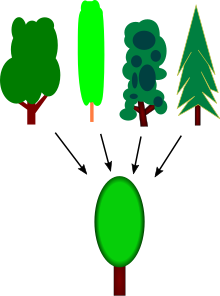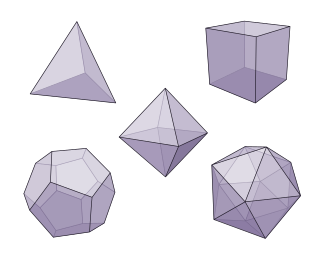
In mathematics, cardinality describes a relationship between sets which compares their relative size. For example, the sets and are the same size as they each contain 3 elements. Beginning in the late 19th century, this concept was generalized to infinite sets, which allows one to distinguish between different types of infinity, and to perform arithmetic on them. There are two notions often used when referring to cardinality: one which compares sets directly using bijections and injections, and another which uses cardinal numbers. The cardinality of a set may also be called its size, when no confusion with other notions of size is possible.

In mathematics, a set A is a subset of a set B if all elements of A are also elements of B; B is then a superset of A. It is possible for A and B to be equal; if they are unequal, then A is a proper subset of B. The relationship of one set being a subset of another is called inclusion. A is a subset of B may also be expressed as B includes A or A is included in B. A k-subset is a subset with k elements.
In mathematics, a well-order on a set S is a total ordering on S with the property that every non-empty subset of S has a least element in this ordering. The set S together with the ordering is then called a well-ordered set. In some academic articles and textbooks these terms are instead written as wellorder, wellordered, and wellordering or well order, well ordered, and well ordering.
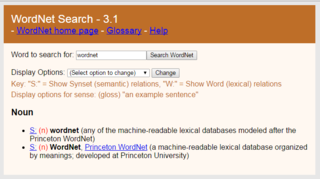
WordNet is a lexical database of semantic relations between words that links words into semantic relations including synonyms, hyponyms, and meronyms. The synonyms are grouped into synsets with short definitions and usage examples. It can thus be seen as a combination and extension of a dictionary and thesaurus. While it is accessible to human users via a web browser, its primary use is in automatic text analysis and artificial intelligence applications. It was first created in the English language and the English WordNet database and software tools have been released under a BSD style license and are freely available for download from that WordNet website. Until about 2024 the English WordNet could be used as an online dictionary/lexical database, and references with links to single words could be made, but thereafter one have to download the database to use it. There are now WordNets in more than 200 languages.
CycL in computer science and artificial intelligence, is an ontology language used by Douglas Lenat's Cyc artificial intelligence project. Ramanathan V. Guha was instrumental in designing early versions of the language. A close CycL variant exists named MELD.
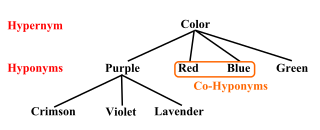
Hypernymy and hyponymy are the semantic relations between a generic term (hypernym) and a more specific term (hyponym). The hypernym is also called a supertype, umbrella term, or blanket term. The hyponym names a subtype of the hypernym. The semantic field of the hyponym is included within that of the hypernym. For example, pigeon, crow, and hen are all hyponyms of bird and animal; bird and animal are both hypernyms of pigeon, crow, and hen.
A faulty generalization is an informal fallacy wherein a conclusion is drawn about all or many instances of a phenomenon on the basis of one or a few instances of that phenomenon. It is similar to a proof by example in mathematics. It is an example of jumping to conclusions. For example, one may generalize about all people or all members of a group from what one knows about just one or a few people:
In database design, object-oriented programming and design, has-a is a composition relationship where one object "belongs to" another object, and behaves according to the rules of ownership. In simple words, has-a relationship in an object is called a member field of an object. Multiple has-a relationships will combine to form a possessive hierarchy.
In knowledge representation and ontology components, including for object-oriented programming and design, is-a is a subsumptive relationship between abstractions, wherein one class A is a subclass of another class B . In other words, type A is a subtype of type B when A's specification implies B's specification. That is, any object that satisfies A's specification also satisfies B's specification, because B's specification is weaker.
Discrete mathematics is the study of mathematical structures that are fundamentally discrete rather than continuous. In contrast to real numbers that have the property of varying "smoothly", the objects studied in discrete mathematics – such as integers, graphs, and statements in logic – do not vary smoothly in this way, but have distinct, separated values. Discrete mathematics, therefore, excludes topics in "continuous mathematics" such as calculus and analysis.
Order theory is a branch of mathematics that investigates the intuitive notion of order using binary relations. It provides a formal framework for describing statements such as "this is less than that" or "this precedes that". This article introduces the field and provides basic definitions. A list of order-theoretic terms can be found in the order theory glossary.
The fallacy of composition is an informal fallacy that arises when one infers that something is true of the whole from the fact that it is true of some part of the whole. A trivial example might be: "This tire is made of rubber; therefore, the vehicle of which it is a part is also made of rubber." This is fallacious, because vehicles are made with a variety of parts, most of which are not made of rubber. The fallacy of composition can apply even when a fact is true of every proper part of a greater entity, though. A more complicated example might be: "No atoms are alive. Therefore, nothing made of atoms is alive." This statement is incorrect, due to emergence, where the whole possesses properties not present in any of the parts.
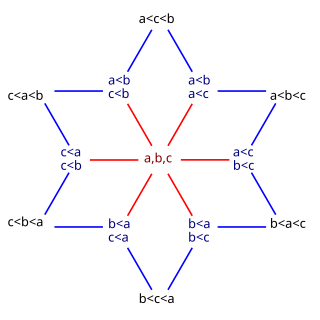
In mathematics, especially order theory, a weak ordering is a mathematical formalization of the intuitive notion of a ranking of a set, some of whose members may be tied with each other. Weak orders are a generalization of totally ordered sets and are in turn generalized by (strictly) partially ordered sets and preorders.
In the philosophy of science and some other branches of philosophy, a "natural kind" is an intellectual grouping, or categorizing of things, that is reflective of the actual world and not just human interests. Some treat it as a classification identifying some structure of truth and reality that exists whether or not humans recognize it. Others treat it as intrinsically useful to the human mind, but not necessarily reflective of something more objective. Candidate examples of natural kinds are found in all the sciences, but the field of chemistry provides the paradigm example of elements. Alexander Bird and Emma Tobin see natural kinds as relevant to metaphysics, epistemology, and the philosophy of language, as well as the philosophy of science.
Ontology learning is the automatic or semi-automatic creation of ontologies, including extracting the corresponding domain's terms and the relationships between the concepts that these terms represent from a corpus of natural language text, and encoding them with an ontology language for easy retrieval. As building ontologies manually is extremely labor-intensive and time-consuming, there is great motivation to automate the process.
In geography and particularly in geographic information science, a geographic feature or simply feature is a representation of phenomenon that exists at a location in the space and scale of relevance to geography; that is, at or near the surface of Earth. It is an item of geographic information, and may be represented in maps, geographic information systems, remote sensing imagery, statistics, and other forms of geographic discourse. Such representations of phenomena consist of descriptions of their inherent nature, their spatial form and location, and their characteristics or properties.
Cartographic generalization, or map generalization, includes all changes in a map that are made when one derives a smaller-scale map from a larger-scale map or map data. It is a core part of cartographic design. Whether done manually by a cartographer or by a computer or set of algorithms, generalization seeks to abstract spatial information at a high level of detail to information that can be rendered on a map at a lower level of detail.
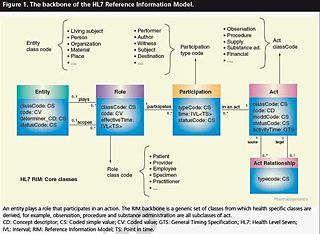
Generic data models are generalizations of conventional data models. They define standardised general relation types, together with the kinds of things that may be related by such a relation type.
In natural language processing, semantic compression is a process of compacting a lexicon used to build a textual document by reducing language heterogeneity, while maintaining text semantics. As a result, the same ideas can be represented using a smaller set of words.

Taxonomy is a practice and science concerned with classification or categorization. Typically, there are two parts to it: the development of an underlying scheme of classes and the allocation of things to the classes (classification).
